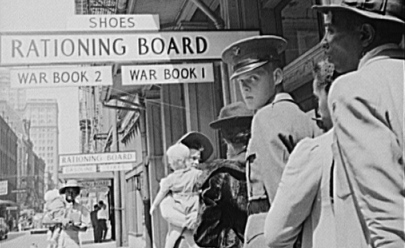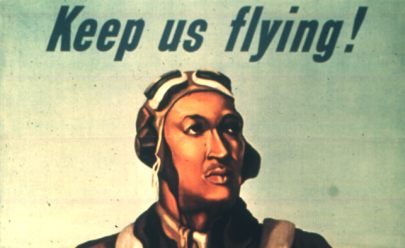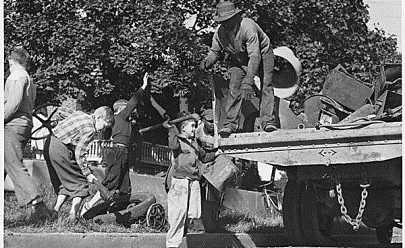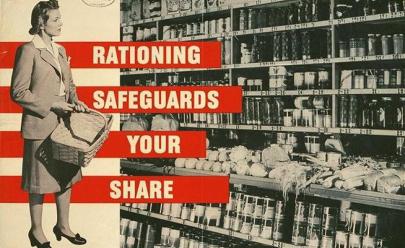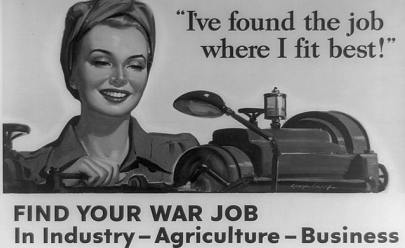AMERICA GOES TO WAR:
December 7, 1941: A Day That Will Live in Infamy
America's isolation from war ended on December 7, 1941, when Japan staged a surprise attack on American military installations in the Pacific. The most devastating strike came at Pearl Harbor, the Hawaiian naval base where much of the US Pacific Fleet was moored. In a two-hour attack, Japanese warplanes sank or damaged 18 warships and destroyed 164 aircraft. Over 2,400 servicemen and civilians lost their lives.
America's Reaction
"No matter how long it may take us to overcome this premeditated invasion, the American people in their righteous might will win through to absolute victory."
-- President Franklin D. Roosevelt, December 8, 1941
Though stunned by the events of December 7, Americans were also resolute. On December 8, President Roosevelt asked Congress to declare war against Japan. The declaration passed with just one dissenting vote. Three days later, Germany and Italy, allied with Japan, declared war on the United States. America was now drawn into a global war. It had allies in this fight--most importantly Great Britain and the Soviet Union. But the job the nation faced in December 1941 was formidable.
![]()
Joining the Military
The United States faced a mammoth job in December 1941. Ill-equipped and wounded, the nation was at war with three formidable adversaries. It had to prepare to fight on two distant and very different fronts, Europe and the Pacific.
America needed to quickly raise, train, and outfit a vast military force. At the same time, it had to find a way to provide material aid to its hard-pressed allies in Great Britain and the Soviet Union.
Meeting these challenges would require massive government spending, conversion of existing industries to wartime production, construction of huge new factories, changes in consumption, and restrictions on many aspects of American life. Government, industry, and labor would need to cooperate. Contributions from all Americans, young and old, men and women, would be necessary to build up what President Roosevelt called the "Arsenal of Democracy."
In the months after Pearl Harbor, the nation swiftly mobilized its human and material resources for war. The opportunities and sacrifices of wartime would change America in profound, and sometimes unexpected, ways.
Recruitment
The primary task facing America in 1941 was raising and training a credible military force. Concern over the threat of war had spurred President Roosevelt and Congress to approve the nation's first peacetime military draft in September 1940. By December 1941 America's military had grown to nearly 2.2 million soldiers, sailors, airmen, and marines.
America's armed forces consisted largely of "citizen soldiers",men and women drawn from civilian life. They came from every state in the nation and all economic and social strata. Many were volunteers, but the majority,roughly 10 million,entered the military through the draft. Most draftees were assigned to the army. The other services attracted enough volunteers at first, but eventually their ranks also included draftees.
Barracks Life
Upon their arrival at the training camps, inductees were stripped of the freedom and individuality they had enjoyed as civilians. They had to adapt to an entirely new way of living, one that involved routine inspections and strict military conduct, as well as rigorous physical and combat training. They were given identical haircuts, uniforms, and equipment, and were assigned to spartan barracks that afforded no privacy and little room for personal possessions.
The Draft
By late 1942 all men aged 18 to 64 were required to register for the draft, though in practice the system concentrated on men under 38. Eventually 36 million men registered. Individuals were selected from this manpower pool for examination by one of over 6,000 local draft boards. These boards, comprised of citizens from individual communities, determined if a man was fit to enter the military. They considered factors like the importance of a man's occupation to the war effort, his health, and his family situation. Many men volunteered rather than wait to be drafted. That way, they could choose their branch of service.
Potential servicemen reported to military induction centers to undergo physical and psychiatric examinations. If a man passed these exams, he was fingerprinted and asked which type of service he preferred, though his assignment would be based on the military's needs. After signing his induction papers, he was issued a serial number. The final step was the administration of the oath. He was now in the military. After a short furlough, he reported to a reception center before being shipped to a training camp. New recruits faced more medical examinations, inoculations, and aptitude tests.
Training
The training camp was the forge in which civilians began to become military men and women. In the training camps new servicemen and women underwent rigorous physical conditioning. They were drilled in the basic elements of military life and trained to work as part of a team. They learned to operate and maintain weapons. They took tests to determine their talents and were taught more specialized skills. Paratroopers, antiaircraft teams, desert troops, and other unique units received additional instruction at special training centers.
The Home Front
"I need not repeat the figures. The facts speak for themselves.... These men could not have been armed and equipped as they are had it not been for the miracle of production here at home. The production which has flowed from the country to all the battlefronts of the world has been due to the efforts of American business, American labor, and American farmers, working together as a patriotic team."
--President Franklin D. Roosevelt, Navy Day speech, October 27, 1944
Raising an armed force was just part of America's war effort. That force had to be supplied with the uniforms, guns, tanks, ships, warplanes, and other weapons and equipment needed to fight. With its vast human and material resources, the United States had the potential to supply both itself and its allies. But first the American economy had to be converted to war production.
The war production effort brought immense changes to American life. As millions of men and women entered the service and production boomed, unemployment virtually disappeared. The need for labor opened up new opportunities for women and African Americans and other minorities. Millions of Americans left home to take jobs in war plants that sprang up around the nation. Economic output skyrocketed.
The war effort on the "Home Front" required sacrifices and cooperation. "Don't you know there's a war on?" was a common expression. Rationing became part of everyday life. Americans learned to conserve vital resources. They lived with price controls, dealt with shortages of everything from nylons to housing, and volunteered for jobs ranging from air raid warden to Red Cross worker.
Rationing and Recycling
"Food for Victory"
To conserve and produce more food, a "Food for Victory" campaign was launched. Eating leftovers became a patriotic duty and civilians were urged to grow their own vegetables and fruits. Millions of "Victory gardens," planted and maintained by ordinary citizens, appeared in backyards, vacant lots, and public parks. They produced over 1 billion tons of food. Americans canned food at home and consulted "Victory cookbooks" for recipes and tips to make the most of rationed goods.
"Make It Do or Do Without"
War production created shortages of critical supplies. To overcome these shortages, war planners searched for substitutes. One key metal in limited supply was copper. It was used in many war-related products, including assault wire. The military needed millions of miles of this wire to communicate on battlefields.
To satisfy the military's demands, copper substitutes had to be found to use in products less important to the nation's defense. The US Mint helped solve the copper shortage. During 1943 it made pennies out of steel. The Mint also conserved nickel, another important metal, by removing it from 5-cent coins. Substitutions like these helped win the production battle.
"Do With Less, So They'll Have More"
The military needed more than guns and ammunition to do its job. It had to be fed. The Army's standard K ration included chocolate bars, which were produced in huge numbers. Cocoa production was increased to make this possible.
Sugar was another ingredient in chocolate. It was also used in chewing gum, another part of the K ration. Sugar cane was needed to produce gunpowder, dynamite, and other chemical products.
To satisfy the military's needs, sugar was rationed to civilians. The government also rationed other foods, including meat and coffee. Local rationing boards issued coupons to consumers that entitled them to a limited supply of rationed items.
"Save Waste Fat for Explosives"
Ammunition for rifles, artillery, mortars, and other weapons was one of the most important manufacturing priorities of World War II. A key ingredient needed to make the explosives in much ammunition was glycerine.
To help produce more ammunition, Americans were encouraged to save household waste fat, which was used to make glycerine. Other household goods,including rags, paper, silk, and string,were also recycled. This was a home front project that all Americans could join.
Salvage for Victory
Canteens are a standard part of military equipment. Millions were produced during the war. Most were made of steel or aluminum, metals which were also used to make everything from ammunition to ships. At times, both metals were in short supply.
To meet America's metal needs, scrap was salvaged from basements, backyards, and attics. Old cars, bed frames, radiators, pots, and pipes were just some of the items gathered at metal "scrap drives" around the nation. Americans also collected rubber, tin, nylon, and paper at salvage drives.
"Share Your Cars and Spare Your Tires"
America's military needed millions of tires for jeeps, trucks, and other vehicles. Tires required rubber. Rubber was also used to produce tanks and planes. But when Japan invaded Southeast Asia, the United States was cut off from one of its chief sources of this critical raw product.
America overcame its rubber shortage in several ways. Speed limits and gas rationing forced people to limit their driving. This reduced wear and tear on tires. A synthetic rubber industry was created. The public also carpooled and contributed rubber scrap for recycling.
Dollars for Defense
To help pay for the war, the government increased corporate and personal income taxes. The federal income tax entered the lives of many Americans. In 1939 fewer than 8 million people filed individual income tax returns. In 1945 nearly 50 million filed. The withholding system of payroll deductions was another wartime development. The government also borrowed money by selling "war bonds" to the public. With consumer goods in short supply, Americans put much of their money into bonds and savings accounts.
Mobilizing the Economy
America's economy performed astonishing feats during World War II. Manufacturers retooled their plants to produce war goods. But this alone was not enough. Soon huge new factories, built with government and private funds, appeared around the nation. Millions of new jobs were created and millions of Americans moved to new communities to fill them. Annual economic production, as measured by the Gross National Product (GNP), more than doubled, rising from $99.7 billion in 1940 to nearly $212 billion in 1945.
Production Miracles In industry after industry Americans performed production miracles. One story helps capture the scale of the defense effort. In 1940 President Roosevelt shocked Congress when he proposed building 50,000 aircraft a year. In 1944 the nation made almost double that number. Ford's massive Willow Run bomber factory alone produced nearly one plane an hour by March 1944.
To achieve increases like this, defense spending jumped from $1.5 billion in 1940 to $81.5 billion in 1945. By 1944 America led the world in arms production, making more than enough to fill its military needs. At the same time, the United States was providing its allies in Great Britain and the Soviet Union with critically needed supplies.
Civilian Defense
Many Americans volunteered to defend the nation from enemy bombing or invasion. They trained in first aid, aircraft spotting, bomb removal, and fire fighting. Air raid wardens led practice drills, including blackouts. By mid-1942 over 10 million Americans were civil defense volunteers.
Though America's mainland was never invaded, there were dangers offshore. Several Japanese submarines were spotted near the Pacific coast, and German U-boats patrolled the Atlantic coast, the Gulf of Mexico, and the Caribbean Sea. At least 10 US naval vessels were sunk or damaged by U-boats operating in American waters.
A Workforce Changed by War: Unemployment Disappears
The war virtually ended unemployment in America. The need for workers led manufacturers to hire women, teenagers, the aged, and minorities previously excluded by discrimination from sectors of the economy. Plentiful overtime work contributed to rising wages and increased savings.
Military and economic expansion created labor shortages. To fill the gap, government and industry encouraged women to enter the workforce. Though most working women continued to labor in more traditional employment like waitressing and teaching, millions took better-paid jobs in defense factories.
African Americans and other minorities also took high-paying industrial jobs previously reserved for whites. In 1941, black labor leader A. Philip Randolph threatened to organize a protest march on Washington, D.C. if the government didn't bar racial discrimination in defense plants with government contracts. Faced with this threat, President Roosevelt banned such discrimination and created the Fair Employment Practices Commission (FEPC) to investigate bias charges.
Millions of women, including many mothers, entered the industrial workforce during the war. They found jobs in especially large numbers in the shipbuilding and aircraft industries. "Rosie the Riveter" became a popular symbol of patriotic womanhood. Though defense jobs paid far more than traditional "female" occupations, women were still often paid less than men performing comparable work. Moreover, at war's end, women were expected to leave the factories to make way for returning male veterans.
Higgins Boats
Higgins Industries designed and built two basic classes of military craft.
The first was landing craft, constructed of wood and steel and used to transport fully armed troops, light tanks, field artillery, and other mechanized equipment and supplies to shore. These boats helped make the amphibious landings of World War II possible.
Higgins also designed and manufactured supply vessels and specialized patrol craft, including high-speed PT boats, antisubmarine boats, and dispatch boats.
LCVP (Landing Craft, Vehicle, Personnel)
The LCVP was the most famous landing craft designed and produced by Higgins Industries. It could land soldiers, and even jeeps, on a beach. LCVPs were used in North Africa, Europe, and the Pacific during the war.
From the Eureka...
The LCVP (Landing Craft, Vehicle, Personnel), the best-known landing craft designed by Andrew Higgins, evolved from a boat he created before the war for use in the swamps and marshes of Louisiana. Trappers and oil companies needed a rugged, shallow-bottomed craft that could navigate these waters, run aground, and retract itself without damaging its hull. Higgins developed a boat that could perform all these tasks: a spoonbill-bowed craft he called the Eureka. Over time he modified and improved his craft and found markets for it in the United States and abroad.
...to the LCP(L)
During the 1930s Higgins tried to interest the U.S. Navy in adapting his shallow-draft Eureka for use as an amphibious landing craft. The navy showed little interest, but Higgins persisted. After a long struggle, he finally secured a government contract to build modified Eurekas for military use. The new boat was called the LCP (Landing Craft, Personnel) and, later, the LCP(L) (Landing Craft, Personnel, Large). In its most advanced form the LCP(L) measured 36 feet in length. It could transport men from ships offshore directly onto a beach, then retract itself, turn, and head back to sea.
The LCVP (Landing Craft, Vehicle, Personnel) was developed because the U.S. Marines needed a boat capable of transporting vehicles to shore. Higgins adapted the LCP(L) to meet this requirement. He replaced the LCP(L)'s rounded bow with a retractable ramp. The new craft was tested for the first time on May 26, 1941, on Lake Pontchartrain. It carried a truck and 36 Higgins employees safely to shore. The LCVP became the military's standard vehicle and personnel landing craft. Thousands were in service during the war.
New Orleans" Home of the Higgins Boats
"If Higgins had not designed and built those LCVPs, we never could have landed over an open beach. The whole strategy of the war would have been different."
--General Dwight D. Eisenhower
The city of New Orleans made a unique and crucial contribution to America's war effort. This was the home of Higgins Industries, a small boat company owned by a flamboyant entrepreneur named Andrew Jackson Higgins. The story of Higgins' role in the war is little known today, but his contribution to the Allied victory was immeasurable.
World War II presented Allied war planners with a tactical dilemma--how to make large amphibious landings of armies against defended coasts. For America this was a particularly thorny problem, since its armed forces had to mount amphibious invasions at sites ranging from Pacific atolls to North Africa to the coast of France.
Higgins' contribution was to design and mass-produce boats that could ferry soldiers, jeeps, and even tanks from a ship at sea directly onto beaches. Such craft gave Allied planners greater flexibility. They no longer needed to attack heavily defended ports before landing an assault force. Higgins' boats were used in every major American amphibious operation of World War II. His achievements earned him many accolades. The greatest came from General Dwight D. Eisenhower, who called Higgins "the man who won the war for us."
From the Bayou to the Battlefront
Before World War II Andrew Higgins operated a small boatyard, building workboats designed to operate in the shallow waters of Louisiana's bayous. During the 1920s and 1930s America's military began exploring ways to make amphibious landings. Higgins became involved in this effort, adapting designs for shallow-draft boats he had developed for peacetime uses. His company created amphibious assault craft capable of shuttling men and equipment quickly and safely from ship to shore. When the war came, business boomed. Higgins built new factories with mass production lines and employed thousands of workers. He even opened a training school for boat operators.
New Orleans Naval Giant During World War II Higgins Industries grew from a small business operating a single boatyard into the largest private employer in Louisiana. The company turned out astounding numbers of boats and ships. In September 1943 the US Navy had 14,072 vessels. Of these, 8,865 had been designed and built by Higgins Industries.
TAKE ACTION:


EDUCATION PROJECTS:
Student Travel – WWII Educational Tours
High school and college students, learn the leadership principles that helped win WWII on a trip to France or during a weeklong residential program in New Orleans. College credit is available, and space is limited.
See You Next Year! HS Yearbooks from WWII
Collected from across the United States, the words and pictures of these yearbooks present a new opportunity to experience the many challenges, setbacks and triumphs of the war through the eyes of America’s youth.
The Victory Gardens of WWII
Visit the Classroom Victory Garden Project website to learn about food production during WWII, find lesson plans and activities for elementary students, get tips for starting your own garden and try out simple Victory Garden recipes!
The Science and Technology of WWII
Visit our new interactive website to learn about wartime technical and scientific advances that forever changed our world. Incorporates STEM principles to use in the classroom.
Kids Corner: Fun and Games!
Make your own propaganda posters, test your memory, solve puzzles and more! Learn about World War II and have fun at the same time.


